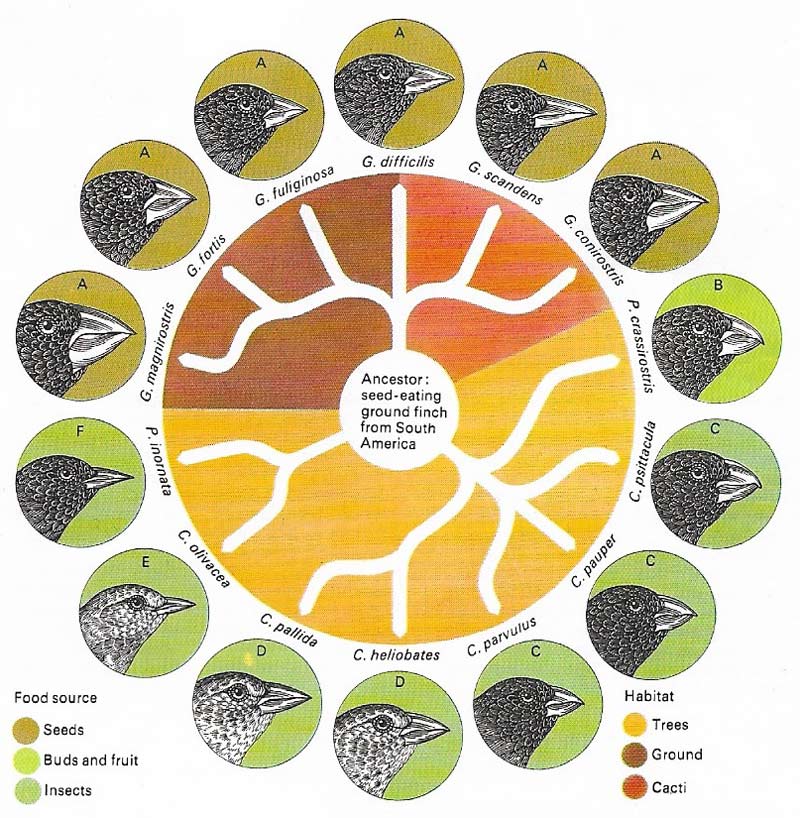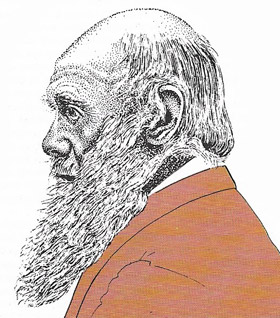natural selection

Figure 1. The finches of the Galapagos Islands provided Darwin with an important clue to his theory of evolution. They are a perfect example of how small, localized populations can evolve. All the modern finches are thought to have descended from a single line of birds that flew from South America. When they arrived there were no indigenous finches on the islands. The invading birds were all seed eaters. Some adapted to tree living, others to a cactus habitat and still others to the ground. The different populations adapted to different foods and this is reflected in the shape of the beak. The ecological and geographical separation allowed divergent evolution until separate species developed which are unable to interbreed. Today there are 14 different species on the islands classified in six separate genera: (A) Geospiza sp; (B) Platyspiza sp; (C) Camarhynchus sp; (D) Cactospiza sp; (E) Certhidea sp; (F) Pinaroloxies sp.

Figure 2. Natural selection of a population for dark coloration.
Natural selection is the differential reproduction of genotypes due to factors in the environment. In the words of Charles Darwin, who first expounded the idea: "Natural Selection is the principle by which each slight variation, if useful, is preserved."
 |
| Charles Darwin |
Darwin's realization
In his explorations during his five-year voyage aboard HMS Beagle, Darwin was impressed by the subtle variation between species, particularly among the finches on the Galapagos Islands. Darwin noticed that in almost all organisms there is a massive production of potential offspring (whether eggs or spores), and that only a few survive. Life, then was a struggle for existence. The next important step in the development of Darwin's ideas was his recognition of the great individual variation within populations.
The combination of these two points produced a third: those variants that survived to adulthood in the struggle for life were, presumably, the ones most fit to do so. Darwin supposed that individual variation could be inherited by offspring from their parents. He therefore saw evolution operating through the natural selection of inheritable characteristics.
Darwin first developed the theory as early as 1838 but felt unable to publish it, perhaps because it went so much against his father's beliefs. Eventually he was virtually forced into publishing when Alfred Russell Wallace (1823–1913) sent Darwin a short paper on his theory of evolution, a theory that matched Darwin's own exactly. The two men presented a joint paper to the Linnean Society in 1858, and Darwin published The Origin of Species a year later.
The process of natural selection
In the process of natural selection, one genotype (the hereditary constitution of an individual) leaves more offspring than another genotype because of superior life attributes, known as fitness. Natural selection acts on genetic variation by conferring a survival advantage to those individuals harboring a particular mutation that tends to favor a changing environmental condition. These individuals then reproduce and pass on this "new" gene, altering their gene pool. Natural selection, therefore, decreases the frequencies of alleles that reduce the fitness of an organism and increases the frequency of alleles that improve fitness.
It is important to understand that natural selection does not always represent progress, only adaptation to a changing surrounding, that is, evolution attributable to natural selection is devoid of intent – something does not evolve to better itself, only to adapt. Because environments are always changing, what was once an advantageous mutation can often become a liability further down the evolutionary line.


